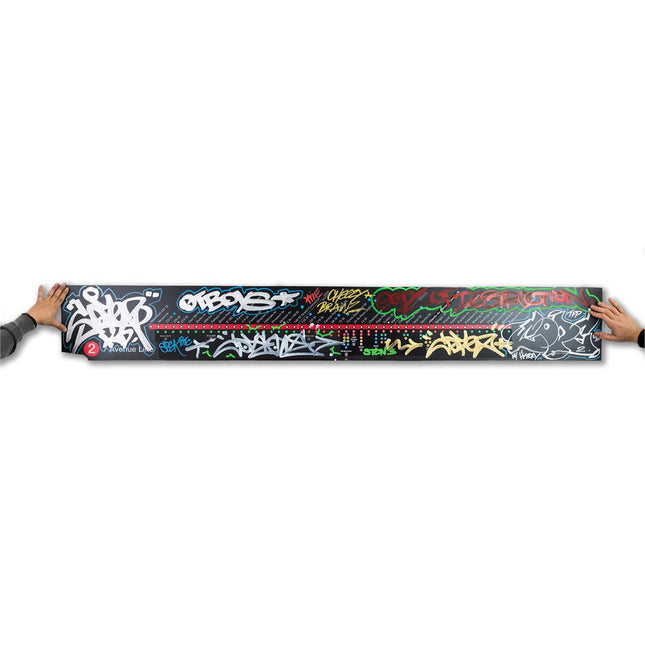The Symbolism of Rainbows in Street Pop Art and Graffiti
The use of rainbows in graffiti street pop art is a testament to this art form's creative, vibrant, and expressive nature. Graffiti, often seen as a way to claim public spaces and give voice to the voiceless, has evolved over the years to incorporate various styles and themes. As a symbol, the rainbow has multiple interpretations and uses in this context. Color and Energy: Graffiti street pop art is known for its bright colors, and the use of a rainbow not only adds to the visual appeal but also enhances the overall energy of the artwork. The bold and contrasting colors of the rainbow create a striking image that immediately captures the viewer's attention. Rainbows, with their ethereal beauty and symbolism of unity and hope, have been a recurring motif in various art forms throughout history. In the realms of Street Pop Art and Graffiti Artwork, the rainbow is a powerful emblem, rich with layers of meaning and used with deliberate intent. Artists have often incorporated the spectrum of colors in their street murals and installations, utilizing its universal allure to convey messages that resonate with a broad audience. The rainbow's symbolism in street art is multifaceted, representing peace, diversity, and inclusivity while also serving as a visual celebration of color. The use of rainbows in street art goes beyond mere aesthetics. It is a statement of solidarity with marginalized communities, most notably the LGBTQ+ community, for whom the rainbow flag is an icon of pride and freedom. Street artists create works that beautify the urban environment and foster a sense of community and support for social causes. The rainbow becomes a bridge connecting the personal with the political, offering a vibrant tableau that encourages viewers to reflect on societal issues.
Rainbows as a Visual Language in Urban Art
Unity and Diversity: The rainbow is often seen as a symbol of unity, as it combines various colors to create a harmonious whole. In graffiti street pop art, incorporating a rainbow can serve as a reminder of the importance of celebrating diversity and inclusiveness within communities. LGBTQ+ Pride: The rainbow symbolizes LGBTQ+ pride and has been associated with the community since the late 1970s. Graffiti artists may use the rainbow to promote acceptance, tolerance, and support for LGBTQ+ individuals or show solidarity with the movement. Hope and Optimism: The rainbow symbolizes hope and optimism, as it often appears after a storm. In graffiti street pop art, incorporating a rainbow can serve as a reminder to remain positive and resilient even in challenging times. Artistic Expression: Graffiti artists often experiment with different styles and techniques. Using a rainbow in their work may be an artistic choice, showcasing their skills in blending and shading various colors to create a visually appealing piece. Rainbows in graffiti street pop art reflect the artists' desire to convey multiple messages and emotions. The rainbow is a powerful and versatile symbol in this urban art form, whether promoting unity, celebrating diversity, or showcasing artistic prowess. In the visual language of urban art, the rainbow serves as a versatile tool for artists to express optimism, dreams, and the ideal of a harmonious society. Its natural occurrence as a meteorological phenomenon that follows the storm is a powerful metaphor for hope and renewal, themes that are particularly resonant in urban communities often grappling with challenges. Graffiti artists, in particular, have harnessed the power of the rainbow's colors to disrupt the often drab cityscapes, injecting life and energy into neglected spaces. The dynamic nature of rainbows, with their fleeting and elusive quality, challenges street artists to capture their essence in a permanent form. This challenge often results in innovative uses of materials and techniques, with artists exploring new ways to evoke the transient beauty of rainbows through paint, light, and even digital media. The rainbow's arc, bending across walls and streets, draws the eye and invites contemplation, becoming a unifying symbol in the diverse language of street art.
Street Pop Art, Graffiti, and the Rainbow Color Spectrum
Street Pop Art and Graffiti Artwork often take inspiration from pop culture and current events, and the rainbow color spectrum offers a universal palette that transcends cultural and linguistic barriers. The colors of the rainbow are employed by artists to celebrate identity and difference, to stand against uniformity and grayness, literally and metaphorically. In this way, the rainbow is not just a visual element but a full-fledged character within the street art narrative, representing life's vibrancy in all its diversity. The rainbow's presence in street art also reminds us of the genre's roots in rebellion and the breaking of conventions. As the rainbow defies the sky's monotony after a rainstorm, street art challenges the status quo, offering an alternative world vision. Artists who work with the rainbow motif continue this tradition of defiance, using its colors to question norms, to celebrate the human spirit, and to call for a more colorful and inclusive world. The rainbow's role in Street Pop Art and Graffiti Artwork is as significant as it is profound. It is a visual feast that speaks to the heart, a symbol that resonates with deep cultural and social significance, and a palette that inspires artists to continue pushing the boundaries of their craft. As long as there are skies to paint upon, the rainbow will undoubtedly continue to feature in the works of street artists, serving as a beacon of hope, a celebration of diversity, and a reminder of the transformative power of art.




